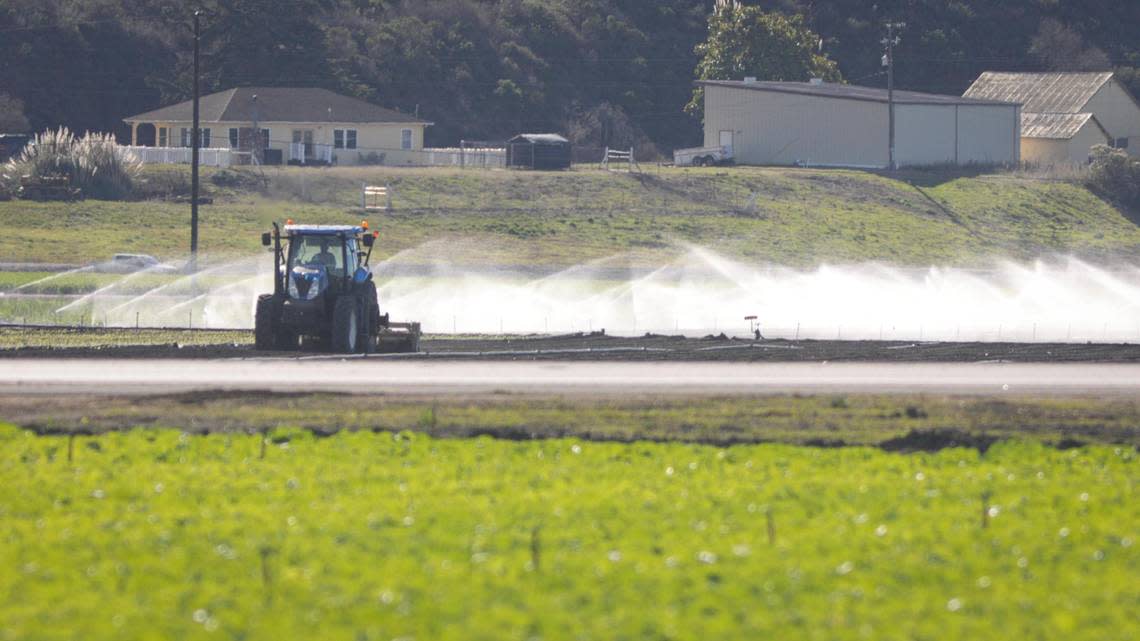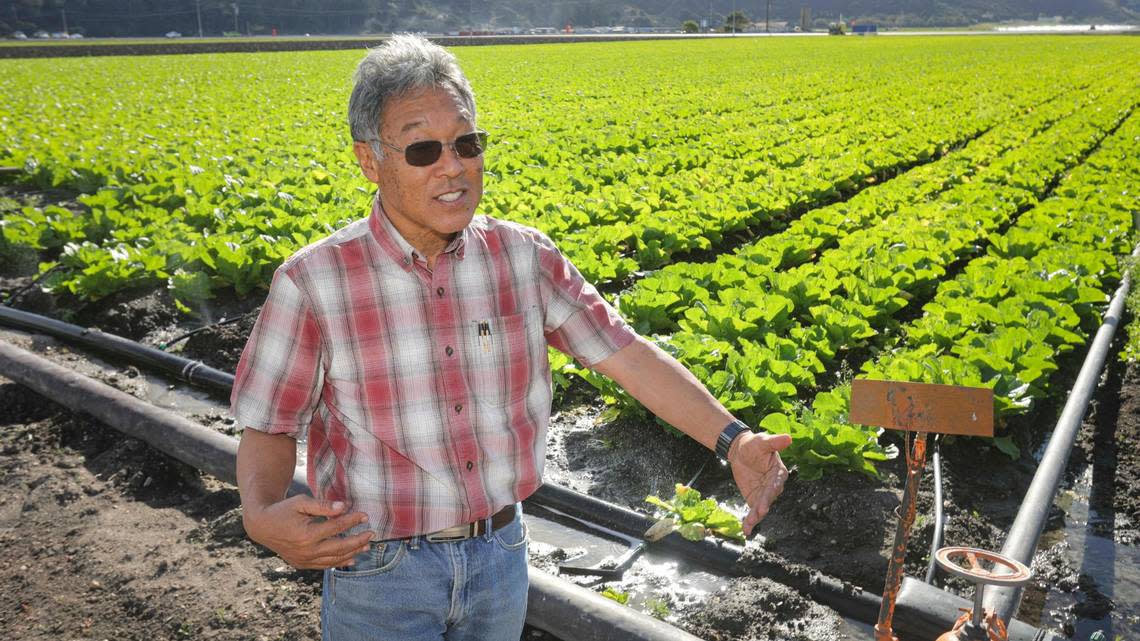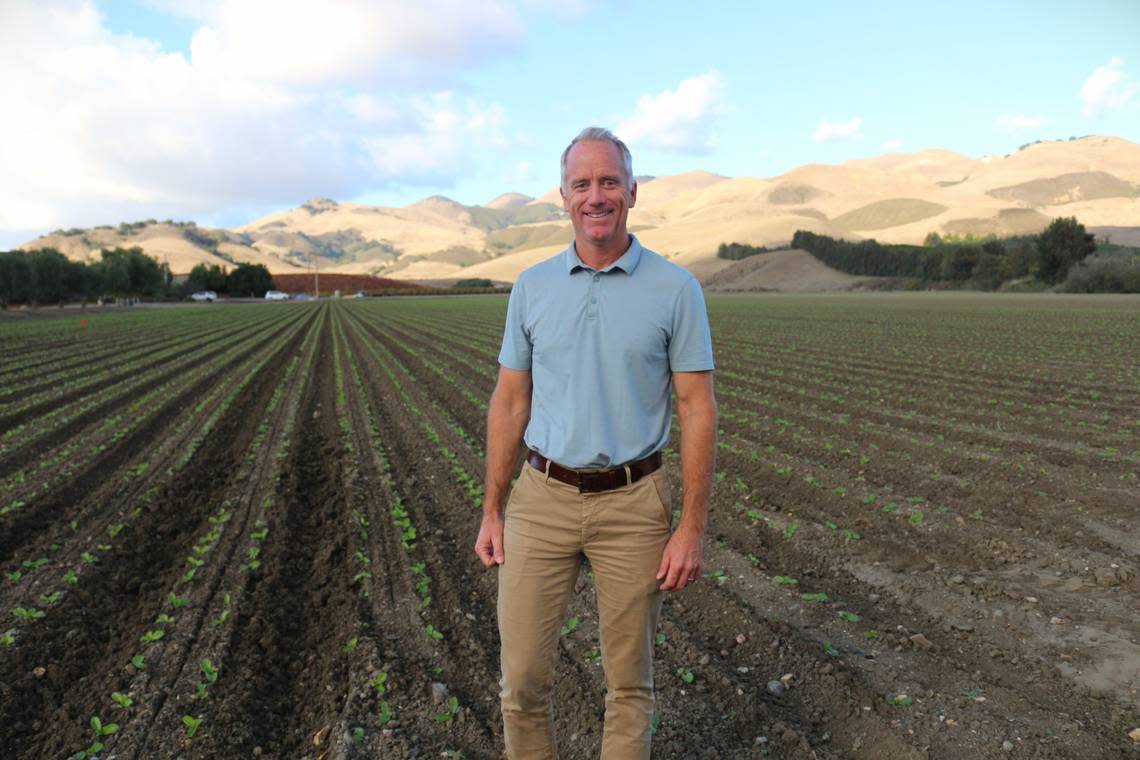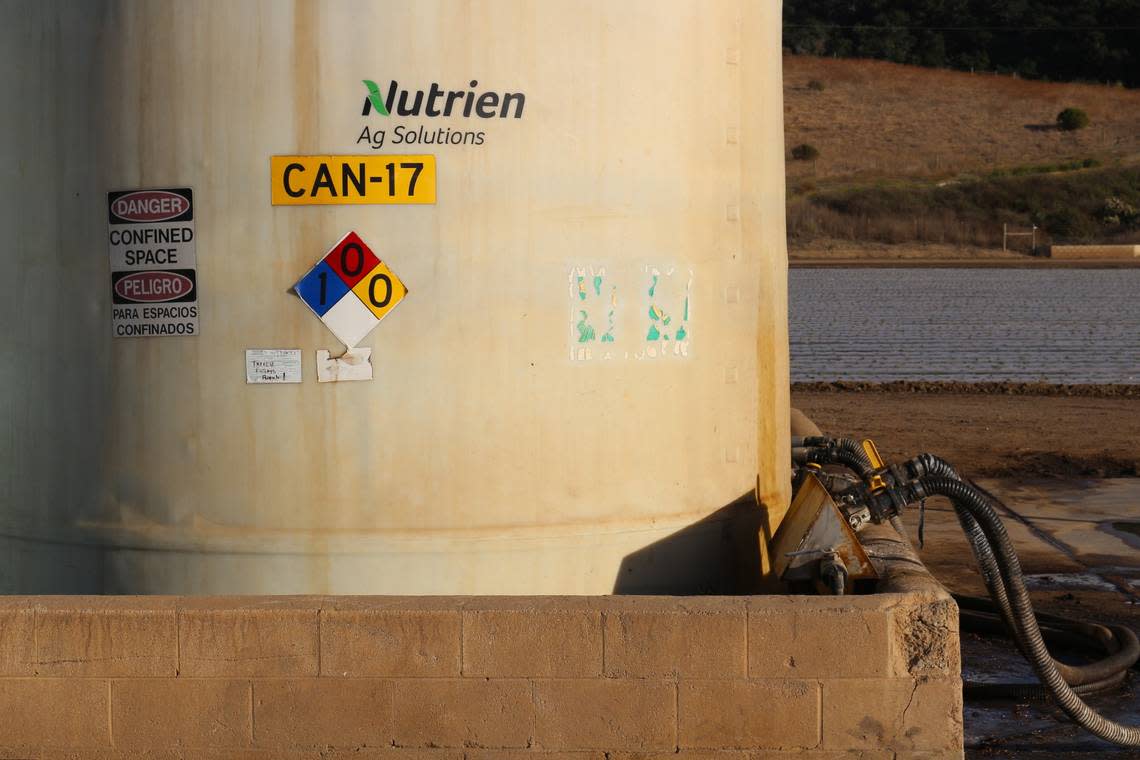SLO County’s groundwater has been polluted by fertilizers. Should farmers cut their use?
California farmers have long been able to spray excessive amounts of nitrogen fertilizers onto their crops to boost growth and ensure a bounty worthy of competitive global markets.
But a battle waging in state court could end with farmers being forced to cut back on a fertilizer they say is critical to their success.
A group of nine environmental groups sued the California State Water Resources Control Board in October to essentially compel the body to implement nitrogen fertilizer restrictions proposed by the Central Coast Water Quality Control Board.
Because crops absorb only a portion of the nitrogen fertilizer that’s applied, the remainder can leach through the soil into the groundwater below. As a result, several San Luis Obispo County groundwater drinking sources, and countless more around the state, are polluted with toxic nitrate, a biochemical byproduct of nitrogen.
Studies show consuming high levels of nitrate in drinking water can affect how blood carries oxygen, cause headaches, nausea and rashes, as well as lead to an increased risk of cancer.
As a result, most water systems in the county have installed expensive treatment systems to ensure residents aren’t exposed to the chemical.
The Central Coast water board, the body charged with protecting groundwater along California’s Central Coast, attempted in 2021 to establish a new regulation to limit the amount of nitrogen fertilizer farmers could apply to their crops in an effort to reduce local groundwater nitrate contamination.
By the end of this year, Ag Order 4.0, among other things, was poised to limit how much nitrogen farmers could apply to crops such as lettuce, broccoli, spinach, cauliflower, celery and strawberries.
But in September, the state water board overturned certain aspects of Ag Order 4.0, specifically noting the numeric limits on how much nitrogen fertilizer farmers could apply to their crops were unprecedented and therefore required further review.
The state has never forced farmers to cut back on their nitrogen fertilizer use. Instead, it has encouraged them to do so through education on best practices.
Now, environmental advocacy groups are suing the state water board to require it to reestablish the enforceable nitrogen fertilizer limits.
“We are tired of the empty promises by our water board to ensure all Californians have access to swimmable, drinkable and fishable waters,” said Sean Bothwell, executive director of the California Coastkeeper Alliance, one of the nine organizations that sued the state in October. “The lack of enforceable groundwater limits and surface water protections only perpetuates the status quo, and the status quo is untenable for California’s disadvantaged communities.”
Farmers, however, say the restrictions could severely hinder their growing operations.

Brent Burchett, the former executive director of the San Luis Obispo County Farm Bureau, said he strongly opposed the nitrogen fertilizer limits proposed by the Central Coast board.
“If this had gone through, there are some parts of our county that would no longer be able to have year-round agriculture,” he said.
As the environmentalists’ lawsuit makes its way through the Superior Court of Sacramento County, the state water board promised, as part of its overturning of the Central Coast’s Ag Order 4.0 nitrogen fertilizer limits, to convene an expert panel to essentially figure out whether limiting nitrogen fertilizer applications would be a feasible way to help clean up the region’s groundwater.
“The approach used by the Central Coast board was not found to be consistent with current expert advice and would not have resulted in sufficient protection of the groundwater critical to the communities served,” wrote state water board spokesperson Edward Ortiz in an emailed statement to The Tribune. “The decision to change these requirements is rooted in the state water board’s standard of using the best data from which to set nitrate values in irrigated lands.”
The state water board has not yet set a date for when it will convene the expert panel, essentially putting the nitrogen fertilizer limits proposed by the Central Coast board on hold until further notice.

Nitrate contaminates many groundwater sources in SLO County
In San Luis Obispo County, dozens of groundwater sources are contaminated with some level of nitrate, according to data from the California Department of Drinking Water.
Communities such as Morro Bay, Los Osos, Nipomo, Grover Beach, the Carrizo Plain and Templeton are among those long burdened with the task of figuring out how to deliver safe, clean water free of nitrate.
The Atascadero Unified School District is working with the state to figure out a solution to its nitrate contamination issue at Carrisa Plains Elementary School.
For more than a decade, the tiny school nestled among legacy ranching and farming operations has been forced to supply students, teachers and staff with bottled water due to levels of nitrate in its water supply as high as seven times above healthy limits, according to state data and district staff.
Recently, a small Nipomo Mesa neighborhood around near Highway 1 and Willow Road has been cautioned by its water purveyor against drinking and cooking with tap water due to levels of nitrate found just above the safe drinking limit of 10 milligrams per liter established by the U.S. Environmental Protection Agency.
The Woodland Park Mutual Water Co. is required by the state to figure out a solution to its polluted water on the Mesa — which wavers between being unsafely contaminated with nitrate to just under the safe limit — by the end of next year.
“This is a really expensive and a really complicated problem to find a solution to,” said Leslie Terry, an environmental health supervisor with the San Luis Obispo County Public Health Agency.
The city of Morro Bay, for example, pays about $35 per acre-foot of water it pumps from its groundwater wells. An acre-foot of water can typically meet the annual needs of two households.
But because its groundwater has long been polluted with nitrate from the farming operations in the Morro Valley, the city must pay a total of about $780 per acre-foot of water because it first has to run it through a reverse osmosis treatment system, according to Damaris Hanson, Morro Bay’s utilities division manager.
As a result, the city mostly relies on imported state water to supply its residents. That costs about $300 per acre-foot of water, according to Hanson.
Golden State Water Co., a statewide water purveyor with operations in San Luis Obispo County, is all too familiar with figuring out how to supply clean water to communities with nitrate-contaminated groundwater sources.
The company uses treatment systems on its wells or blends contaminated water with clean water in Los Osos, Edna Valley and on the Nipomo Mesa, according to Dawn White, a water quality manager with Golden State Water.
“The whole area is vulnerable” to nitrate contamination, White said.

SLO County farmers say they’re working to reduce nitrogen fertilizer use
Some growers, such as Tom Ikeda, a third-generation farmer in the Arroyo Grande Valley, and Ryan Talley of Talley Farms, say they’ve worked to reduce the amount of nitrogen fertilizer they use on their crops.
The two farmers try to “spoon feed” the fertilizer to their crops, both said, delivering as precise an amount as possible directly to the plants.
That way, Talley said he’s cut his nitrogen fertilizer use in half over the past 30 years, while Ikeda said his crops use about 25% of the nitrogen fertilizer his grandfather applied.
The reduction in fertilizer has helped both save money. Nitrogen fertilizer costs about $3 to $6 a gallon — a pretty penny for small farming operations struggling to compete on the global market, both farmers said.
But even with the reduction in their fertilizer use, the farmers fear complying with the Central Coast water board’s proposed nitrogen fertilizer limits could be difficult.
Talley noted that while he may comply with the nitrogen fertilizer limits in some fields, other fields have a different soil mixture or sunlight and rain exposures that could mean more of the fertilizer is needed to produce productive crops year-round.
“Our fields are like children, each one is totally different,” he said. “One may be really rocky and gravelly, so your water, your fertilizer, everything just leaches through right away. The other one may be adobe clay, where it’s really heavy and it holds the moisture, holds the fertilizer much longer.
“So we make adjustments: We may put a little more fertilizer on the shaley rocky soil we have, but then over here in the heavy clay we’re going to probably use a third of the fertilizer,” Talley said.

Recent research helped reveal nitrogen fertilizer can be used more efficiently
A particularly challenging factor in fighting nitrate contamination in groundwater is the chemical’s tendency to stick around in the aquifer for quite a while.
In other words, the farming practices of the 1960s, ‘70s and ‘80s — when farmers more commonly dumped large amounts of nitrogen fertilizer on crops because they didn’t know how much plants used — have led to the groundwater pollution issues still seen today.
“It will take another 20, 40, 60 years to actually improve groundwater quality as a result of what we’re doing today and tomorrow,” said Thomas Harter, a professor and groundwater specialist in the UC Davis agriculture cooperative extension program, which helps mentor and advise farmers on sustainable growing methods.
Harter and other UC Davis cooperative extension program specialists have worked with farmers on the Central Coast for decades to hone their nitrogen fertilizer uses.
“I think we have an opportunity to do this better,” Harter said. “We need to work on a practice that can address the inefficiency in the nitrogen application, we need to figure out practices that growers can use, we need to reach out to growers and we need to train growers on these practices.”
UC Davis research published in 2016 showed that California crops recover, on average, less than half of applied synthetic nitrogen fertilizer, with some crops capturing as little as 30%.
Any nitrogen fertilizer the plants don’t use is susceptible to leaching into the groundwater, according to the university.
Local farmers are required to test annually to determine how much nitrogen fertilizer is used by their crops and how much is left in the soil and therefore vulnerable to moving into the groundwater. Those test results must then be sent to the Central Coast water board.

Farmers and environmentalists at odds with how to solve nitrate contamination issue
The issue of regulating nitrogen fertilizer applications is tricky.
On one hand, farmers say they need it to stay in busy in a competitive global market that demands large quantities of year-round fresh produce at low prices. Stacking another regulation on top of the many they already face could overburden local farmers while perhaps leading to a less productive crop — which could put them out of business.
On the other hand, environmentalists fear that without more stringent regulations, farmers will continue using more nitrogen fertilizer than their crops need — worsening the decades-old toxic nitrate pollution of groundwater.
“After more than 20 years of directing growers to improve their practices, requiring planning, tracking, and reporting of nitrogen use, and requiring growers to obtain education about the water quality impacts of their farms and how to change, the (Central Coast) regional board determined that these approaches were not working,” the environmentalists’ lawsuit said. “During this long period of program implementation, through three general orders and dozens of opportunities for public comment, nitrogen application rates did not decline, and water quality did not improve.”
Implementing Ag Order 4.0’s nitrogen fertilizer limits was the first step in prohibiting “the highest applications of nitrogen” and therefore setting the stage for cleaner water in the future, the lawsuit added.
Ikeda and Talley said they oppose the limits proposed by the Central Coast board.
“I need to put on enough fertilizer to get a marketable crop year-round,” Ikeda said. “Competition is so tough now that you’re saving your pennies everywhere you can. If I don’t need to put it (nitrogen fertilizer) on, that goes to my bottom line.”
Talley emphasized that the owners of many of San Luis Obispo County’s local farming operations live in the communities where they grow their crops and would be just as susceptible to pollution as anyone else.
“The last thing we want to do is something that would harm somebody else,” Talley said. “I drink the same water as everyone else, eat the same produce as everyone else.”
